Introduction
Mitsubishi describes the Lancer Evolution as an “ultra-high-performance luxury sports sedan”. When we hear the term “ultra-high-performance luxury sports sedan”, the first cars that come to our mind are significantly more expensive cars like the
BMW M3, Audi RS4, and Cadillac CTS-V. We don’t think of the economy car based Mitsubishi Lancer Evolution (Evo).
There is no denying the Evo has a rally inspired performance sedan, as its development is a result of multiple title victories in the World Rally Championship (WRC). But we do question its “Luxury” sports sedan claims, since we’ve always just thought of it as a high-performance Lancer that leaned away from the “Luxury” side of the spectrum.
We were given the opportunity to test the 2013 Mitsubishi Lancer Evolution MR to find out if it is a true high-performance luxury sports sedan. According to Mitsubishi, the MR is a more reserved version of the Evo that features a subtler exterior look, a more luxurious cabin, and a more refined ride than the Evo GSR while retaining all of its performance abilities.
Our Evo MR came equipped with the optional Touring Package, Premium Package, and Navigation System Package.
On the Road

The Evo is powered by a DOHC 16-valve 2.0-liter turbocharged and intercooled inline-4-cylinder engine with MIVEC variable valve timing on both the intake and exhaust that makes 291 hp at 6,500 rpm and 300 lb.-ft. of torque starting at 4,400 rpm. Redline is reached at 7,000 rpm. We achieved a 0-60 mph acceleration time of just 5.2 seconds. It launches fairly quickly initially, but once you hit approximately 3,500 rpm, it surges forward throwing you back in your seat and produces a huge grin on your face. Also, since this is an all-wheel-drive car, we exhibited no wheel spin during launches and accelerating hard is effortless regardless of the driving conditions.
The MR comes with the Twin-Clutch Sportronic Shift Transmission (TC-SST) instead of the short throw 5-speed manual transmission that comes wi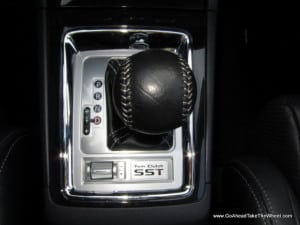 th the GSR. While we were at first disappointed that we couldn’t row our own gears, we were pleasantly surprised and extremely pleased with the twin-clutch unit. Shifts are immediate and smooth, and can be made either automatically, with the console-mounted gear selector, or with the magnesium-alloy steering wheel paddle shifters.
th the GSR. While we were at first disappointed that we couldn’t row our own gears, we were pleasantly surprised and extremely pleased with the twin-clutch unit. Shifts are immediate and smooth, and can be made either automatically, with the console-mounted gear selector, or with the magnesium-alloy steering wheel paddle shifters.
The TC-SST has three automatic drive modes you can select from: Normal, Sport, and S-Sport. In Normal mode, the transmission shifts like a regular automatic transmission. In Sport mode, the shifts points are moved to a higher rpm range. We prefer this setting in spirited on the road. In S-Sport mode, shift points are moved close to redline, and is ideal for the racetrack. While decelerating, the transmission automatically downshifts through the gears and sounds awesome!
Engine sound though, is not one of the more pleasant ones we’ve heard, and resembles a blender at higher engine speeds. Thankfully, it quiets down at lower gears on the highway. The exhaust system with dual outlets gives the Evo a throaty (for a 4-cylinder) exhaust tone which is heard more at idle than on the road. Wind and tire noise are also moderate on the highway too. Thankfully, all these noises can be drowned out by blasting the powerful audio system.
We loved the Steering in the Evo. Although it’s on the heavier side a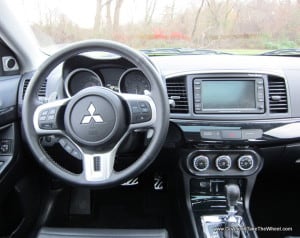 t parking lot speeds, once you get going, the rack-and-pinion hydraulic power assist steering is sensitive to even minor inputs. It responds immediately to your inputs and provides a tremendous amount of feedback that is lacking from many electric power steering systems used in new cars today.
t parking lot speeds, once you get going, the rack-and-pinion hydraulic power assist steering is sensitive to even minor inputs. It responds immediately to your inputs and provides a tremendous amount of feedback that is lacking from many electric power steering systems used in new cars today.
Since the Evo’s is basically a track car for the streets, don’t expect a soft and cushy ride. Its suspension consists of inverted MacPherson struts up front with a multi-link configuration in the rear. The MR adds Eibach springs and Bilstein shock absorbers over the GSR. The ride is busy and bumps can pound through the cabin. On the other hand, consider this is a fair trade-off for a car that handles as magnificently as it does.
Decelerating the Evo is accomplished with a Brembo braking system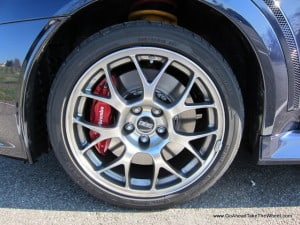 that consists of 4-piston front calipers with 13.8-inch rotors and 2-piston rear calipers with 13.0-inch rotors in the rear, sport tuned anti-lock brakes, and Electronic Brake-force Distribution (EBD). Stopping distances feel short and pedal feel is firm. We didn’t experience any noticeable fade during our time with the car even on the track.
that consists of 4-piston front calipers with 13.8-inch rotors and 2-piston rear calipers with 13.0-inch rotors in the rear, sport tuned anti-lock brakes, and Electronic Brake-force Distribution (EBD). Stopping distances feel short and pedal feel is firm. We didn’t experience any noticeable fade during our time with the car even on the track.
On the Track
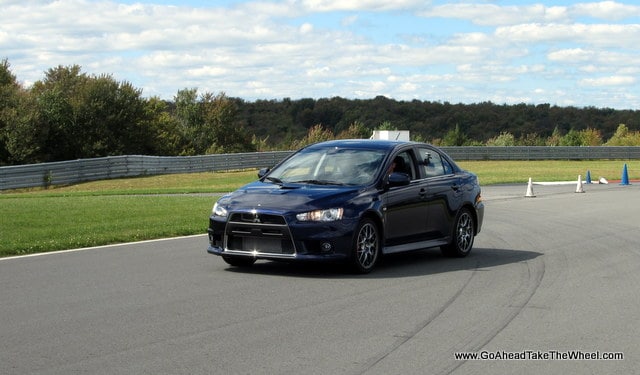 Closed circut courses are where the Evo is most at home, whether it be a paved road track, autocross course, or rally course. After all, this is where the EVO left its mark. Specifically, the World Rally Championship (WRC), where it clinched multiple victories.
Closed circut courses are where the Evo is most at home, whether it be a paved road track, autocross course, or rally course. After all, this is where the EVO left its mark. Specifically, the World Rally Championship (WRC), where it clinched multiple victories.
We drove the Evo on the Monticello Motor Club race track for a few laps to test the performance abilities of this car. What impressed us most is its handling thanks to its Super All-Wheel Control (S-AWC). It is composed of four different systems: all-wheel drive with Active Center Differential which allows up to a 50:50 torque split between the front and rear wheels,a rear differential with Active Yaw Control which controls torque distribution to the vehicle’s rear wheels, anti-lock brakes to keep the vehicle in control while decelerating, and active stability control for improved traction and stability while cornering. With its powerful engine and its ability to send power to the rear wheels, we were even able to induce a little over-steer and steer the vehicle with the throttle which was lots of fun! The S-AWC system has three manually selectable modes: Tarmac, Gravel, and Snow which electronically control the system for optimum performance in each of their respective environments. While we tried the car on some gravel roads and think we felt a difference when putting it in the Gravel mode, but it was difficult to tell at just moderate speeds.
Interior
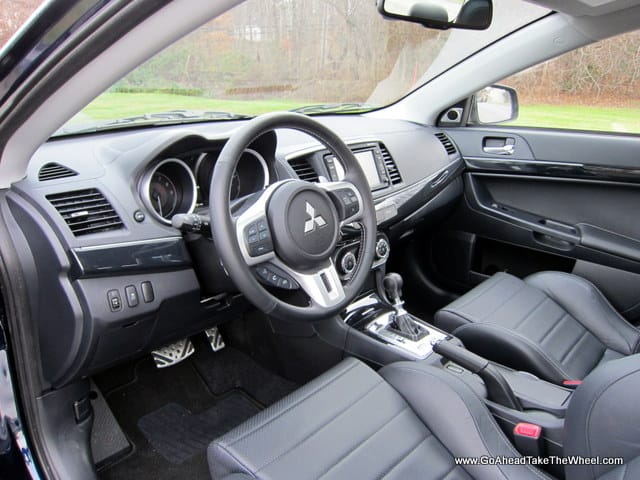 The interior is very similar in appearance to the base Lancer but with several upgrades and amenities found in upscale vehicles. Many materials though, including the hard plastic dashboard, are typical Lancer grade and don’t provide that true sense of luxury that other ultra-high-performance luxury sports sedan provide.
The interior is very similar in appearance to the base Lancer but with several upgrades and amenities found in upscale vehicles. Many materials though, including the hard plastic dashboard, are typical Lancer grade and don’t provide that true sense of luxury that other ultra-high-performance luxury sports sedan provide.
Entering the cabin is assisted with a Free-hand Advanced Security Transmitter “FAST”-Key electronic keyless entry and engine starting system, which allows drivers to unlock the car and drive away without ever taking the keys out of their pockets. The door sills wear an aluminum kick plate with the words “Lancer Evolution”. The interior includes piano black trim which provides a nice upscale look in th e vehicle. It has leather covered heated RECARO front bucket seats with a large amount of lateral support. However, they are only 4-way adjustable. The only adjustments that you can make to these seats are sliding it forward and backwards, and tilting adjustments for the back. Unfortunately side bolstering is too tight for even many average-sized occupants, and they can’t be widened. Also, they are not height adjustable. Headroom and legroom are more than adequate for 6-footers though. The steering wheel and shifter are both wrapped in leather. The steering wheel does tilt, but does not telescope so really tall drivers will have to reach far for the steering wheel.
e vehicle. It has leather covered heated RECARO front bucket seats with a large amount of lateral support. However, they are only 4-way adjustable. The only adjustments that you can make to these seats are sliding it forward and backwards, and tilting adjustments for the back. Unfortunately side bolstering is too tight for even many average-sized occupants, and they can’t be widened. Also, they are not height adjustable. Headroom and legroom are more than adequate for 6-footers though. The steering wheel and shifter are both wrapped in leather. The steering wheel does tilt, but does not telescope so really tall drivers will have to reach far for the steering wheel.
The main gauges consist of a large tachometer, spe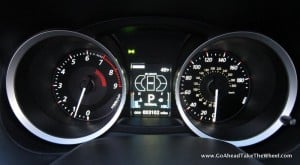 edometer, and color LCD display. They are high contrast and easy to read at a quick glance. The color LCD multi-information display is between the two gauges and provides information such as outside temperature, average fuel consumption, trip odometer and distance to empty. It even warns drivers of possible icy road conditions once the thermometer hit 37 degrees Fahrenheit, and displays the status of the S-AWC system and which wheels are receiving power at any given time.
edometer, and color LCD display. They are high contrast and easy to read at a quick glance. The color LCD multi-information display is between the two gauges and provides information such as outside temperature, average fuel consumption, trip odometer and distance to empty. It even warns drivers of possible icy road conditions once the thermometer hit 37 degrees Fahrenheit, and displays the status of the S-AWC system and which wheels are receiving power at any given time.
The center console contains a 7-inch LCD touchscreen navigation system with real-time traffic, 40 GB HDD, and music server. Since th e touchscreen contains most audio functions, it makes simple functions more complicated than we like, but its complexity is not uncommon for multi-function control touchscreen systems. The music server can store up to 3,000 songs. The sounds system is composed of a powerful 710-watt Rockford-Fosgate premium audio system with a 6-CD/MP3-compatible head unit with Digital Signal Processor (DSP) and 9 speakers (including a trunk-mounted 10-in. subwoofer) and SIRIUS satellite radio. This unit sounds great for a factory unit and provides a deep, rich bass sound that’s strong enough to vibrate the panels inside the car. High notes are clear too but I often wished for even more treble, even with its setting at the maximum level.
e touchscreen contains most audio functions, it makes simple functions more complicated than we like, but its complexity is not uncommon for multi-function control touchscreen systems. The music server can store up to 3,000 songs. The sounds system is composed of a powerful 710-watt Rockford-Fosgate premium audio system with a 6-CD/MP3-compatible head unit with Digital Signal Processor (DSP) and 9 speakers (including a trunk-mounted 10-in. subwoofer) and SIRIUS satellite radio. This unit sounds great for a factory unit and provides a deep, rich bass sound that’s strong enough to vibrate the panels inside the car. High notes are clear too but I often wished for even more treble, even with its setting at the maximum level.
The automatic climate controls consist of three large round rotary knobs that are logically placed and simple to read and operate. This system automatically adjusts fan speed, air source and temperature to keep the cabin at a comfortable level. However, this is not a dual zone system, so you’re unable to have one setting for the driver, and another one for the front passenger.
Other interior features include a power glass sunroof, USB auxiliary input, Mitsubishi Motors’ FUSE Handsfree Link System that allows users to wirelessly connect to their Bluetooth-enabled cell phone, iPod or USB drive by using their voice, cruise control, and power windows, side mirrors and door locks.
Visibility is pretty good on the front and on the sides. However, backing up can be difficult since the fixed head rest on driver’s seat can obstruct visibility, and there’s no rear view camera. C-pillars are a little thick which may obstruct rear corner visibility somewhat, but it isn’t annoying.
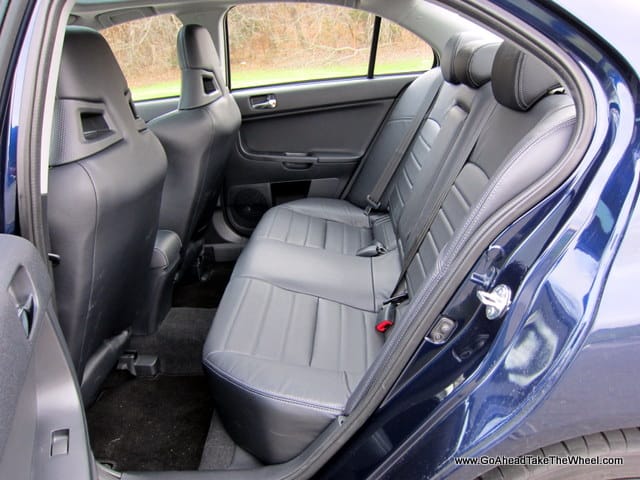 Rear seat access is quite good for a performance car thanks to its 4-door design. The rear seat is comfortable for two average sized adults with adequate headroom and legroom. Even with a rear facing infant car seats installed in the rear passenger side of the car, average sized front occupants should find plenty of room without sacrificing their seating position. For performance car standards, this is very impressive.
Rear seat access is quite good for a performance car thanks to its 4-door design. The rear seat is comfortable for two average sized adults with adequate headroom and legroom. Even with a rear facing infant car seats installed in the rear passenger side of the car, average sized front occupants should find plenty of room without sacrificing their seating position. For performance car standards, this is very impressive.
Exterior
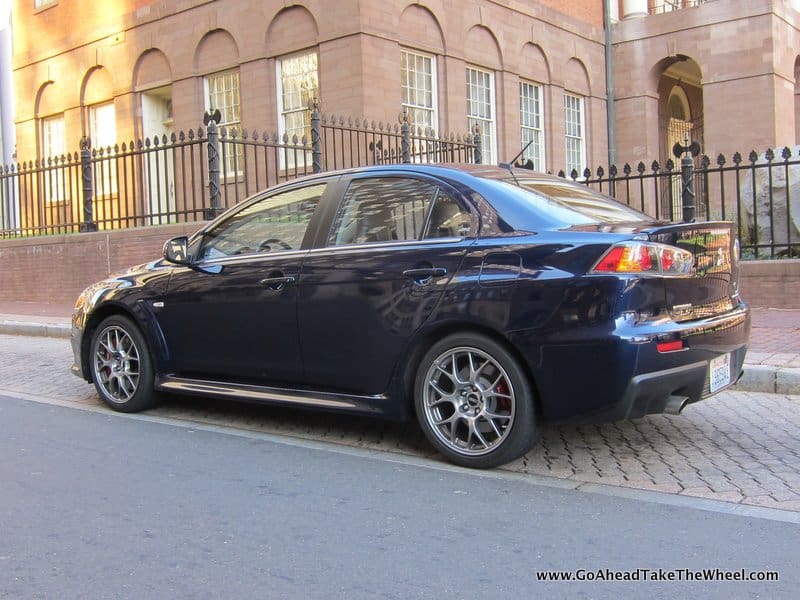 Exterior styling in the Evo MR is more bold and aggressive than in the base Lancer, yet it’s more sophisticated than the Evo GSR. It is designed to enhance aerodynamics and performance. The front is marked with a trapezoid shaped front grille with chrome grille surround and large cooling vent. The lightweight aluminum hood is vented for heat extraction which helps cool the engine and provide better performance, and lowers the center of gravity for better handling. The side view contains flared and vented fenders which help pull heat out of the engine compartment, and smooth airflow within the wheel well to reduce drag caused by its grippy 245/40R18 Yokohama ADVAN asymmetrical performance tires. The rear of the Evo MR contains an integrated lip spoiler as opposed to the in your face rear wing spoiler on the GSR which adds down-force to the rear wheels at high speeds.
Exterior styling in the Evo MR is more bold and aggressive than in the base Lancer, yet it’s more sophisticated than the Evo GSR. It is designed to enhance aerodynamics and performance. The front is marked with a trapezoid shaped front grille with chrome grille surround and large cooling vent. The lightweight aluminum hood is vented for heat extraction which helps cool the engine and provide better performance, and lowers the center of gravity for better handling. The side view contains flared and vented fenders which help pull heat out of the engine compartment, and smooth airflow within the wheel well to reduce drag caused by its grippy 245/40R18 Yokohama ADVAN asymmetrical performance tires. The rear of the Evo MR contains an integrated lip spoiler as opposed to the in your face rear wing spoiler on the GSR which adds down-force to the rear wheels at high speeds.
Storage
 The trunk can be open by either pulling a lever on the floor by the driver’s seat, pressing a button on the key fob, or by pressing a button on the trunk where the key whole normally is (as long as the key fob is with you). Once open, the aperture is large which makes loadings objects easy, but the trunk only holds a disappointing 6.9 cubic feet of luggage volume. Its trunk space is compromised due to the battery and windshield washer fluid reservoir (placed here for enhanced weight distribution) and 10-inch subwoofer. Also, the rear seats don’t fold so the trunk is not expandable. Other storage inside the cabin includes a center storage console, large front door storage pockets with bottle holders, twin cup-holders in the console between the front seats, and fold-down twin cup-holders in the center passenger rear seat back. Beneath the floor of the trunk is a temporary use spare tire.
The trunk can be open by either pulling a lever on the floor by the driver’s seat, pressing a button on the key fob, or by pressing a button on the trunk where the key whole normally is (as long as the key fob is with you). Once open, the aperture is large which makes loadings objects easy, but the trunk only holds a disappointing 6.9 cubic feet of luggage volume. Its trunk space is compromised due to the battery and windshield washer fluid reservoir (placed here for enhanced weight distribution) and 10-inch subwoofer. Also, the rear seats don’t fold so the trunk is not expandable. Other storage inside the cabin includes a center storage console, large front door storage pockets with bottle holders, twin cup-holders in the console between the front seats, and fold-down twin cup-holders in the center passenger rear seat back. Beneath the floor of the trunk is a temporary use spare tire.
Safety
The IIHS hasn’t published test results for the 2013 Mitsubishi Lancer Evolution, but the 2013 Mitsubishi Lancer is an IIHS Top Safety pic that earned good performance in moderate overlap front, side, rollover, and rear tests.
The 2013 Evo comes equipped with a many standard safety features including a dual front air bag supplemental restraint system (SRS) with occupant sensors, front seat-mounted side-impact air bags and side curtain air bags, and a driver’s knee air bag. It also comes equipped with a sport-tuned Anti-lock Braking System (ABS) with Electronic Brakeforce Distribution (EBD) which is designed to improve vehicle control. It does this by automatically shifting braking force between the front and rear axles as needed. It also comes with Active Stability Control (ASC) which monitors traction across all four tires. If it senses a wheel beginning to slip, it automatically applies the brakes to the wheels with the most traction, helping you maintain control of the vehicle in adverse or emergency situations.
Availability
For the 2013 model year, the Japan built Evo is available in two editions: the GSR and the MR.
The Lancer Evolution GSR starts at $35,490 (with destination) and comes equipped with a long list of standard features including 5-speed manual transmission, a large rear deck lid spoiler, RECARO seats, Brembo brakes, leather-wrapped steering wheel, and lightweight Enkei alloy wheels clad with high-performance Yokohama ADVAN tires.
The MR starts at $38,690 (with destination) and includes a 6-speed twin-clutch Sportronic shift transmission (TC-SST), special lightweight two-piece front brake rotors and BBS forged-alloy wheels, an upgraded suspension package that includes Eibach springs and Bilstein shock absorbers, and High-Intensity Discharge (HID) headlamps.
Touring Package adds $2,150 and includes: Power glass sunroof; Leather seating surfaces for RECARO seats; Heated front seats and side mirrors; Auto on/off headlamps; Rain-sensing wipers; Auto dimming rearview mirror; Improved sound insulation.
Premium Package adds $2,000 and includes: 710-watt Rockford-Fosgate Punch premium sound system with 9 speakers including 10-in. subwoofer; SiriusXM satellite radio with 3-month paid service; 6 CD/MP3 in-dash changer; FAST-key entry system; leather/suede combination seating surfaces for RECARO seats; Center console upgrade; Chrome grille surround and beltline molding; Body color fender and hood vents.
Navigation System Package adds $2,295 and includes: 40GB HDD navigation with music server and real time traffic.
The most direct competitors of the Evo are the Subaru Impreza WRX STI and Volkswagen Golf R.
Summary
The Evo is a compact high performance sports sedan that is a lot of fun to drive. It’s really fast, its handling and steering are fantastic, and you can take some of your friends along for a ride with you too. With the right tires, you can have a blast driving it in the snow as well. Where the Golf R is more a street car that can be taken on the track, the Evo is truly is a track car for the street.
On the other hand, the Evo does come with a few compromises. Despite Mitsubishi’s luxury claims, this is not a very comfortable car. The Recaro seats are too confining for most people, the ride is harsh, the trunk is much less usable then you would expect in a sedan, and you’re always aware that you’re driving a vehicle that’s based on a $16,000 car.
The bottom line is, if you’re looking at this car from a luxury standpoint, look elsewhere. But if you’re looking at this car from a performance standpoint, this car has much more appeal. If you’re considering buying a new Evo, we recommend saving yourself several grand and forgoing many of the extra options that jack up the price and do little to improve the purpose of this fun car.
Vehicle type: Front Engine, AWD, 5-Passenger, 4-Door
Base price (including destination): $38,680
Price as tested (including destination): $45,135
Engine: 2.0L MIVEC I4 turbocharged/intercooled
Horsepower: 291 @ 6,500 RPM
Torque: 300 lb.-ft. @ 4,000 RPM
Transmission: 6-Speed Twin-Clutch Sportronic Shift Transmission
Curb Weight: 3,572 lbs
GATTW’s 0 – 60 MPH: 5.2 Seconds
EPA Rating (city/hwy/comb): 17/22/19
Recommended Fuel: Premium Unleaded
[nggallery id=39]


